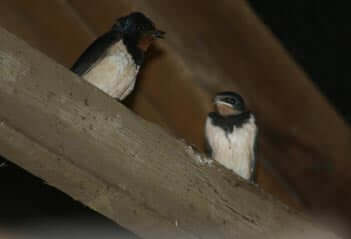
Autumn: Coming and Going
Share
View this blog to see why birds are split into three different types of categories and why...
Broadly speaking birds fit into three categories. The ones that are here all year (residents), the ones that are only here in summer (summer migrants) and the ones that are only here in winter (winter visitors) Let’s deal with the ones that come to Britain to breed...
In fact not many of them are garden birds, or, if they are, they don’t often come to feeders, mainly because they (Swallows, Swifts, House Martins) eat small flying insects. Even Haith’s haven’t got round to stocking them yet! That doesn’t mean that we humans can't help them, especially by providing nest boxes (for Spotted Flycatchers), artificial nests (for Swallows and House Martins), space under the eaves (for Swifts), and leaving some leafy corners wild and untidied may attract a warbler such as Chiffchaff or Blackcap. Ironically Garden Warblers do not really justify the name as they are pretty scarce in gardens.
Most summer migrants should be basking in their winter quarters by now, incredibly some as far away as South Africa. Mind you, every year a few individuals choose to try the British winter. Their chances of survival will of course be greatly enhanced by putting out extra rations.
Blackcaps are becoming an increasingly familiar sight on bird tables and feeders. They may well be German birds, and will return in spring, but probably not before they have had a few practice sings on warm days. The bubbly chortling of a Blackcap is becoming one of the first songs to be heard in a New Year, usual vying with the lonesome fluting of the Missel Thrush.
Amongst the species you will only see in a garden during the winter months (October to April) are notably the winter thrushes, Redwing and Fieldfare. Especially if there is hard frost or heavy snowfall, look out for these visitors from Scandinavia and Iceland. They are particularly partial to red berries and windfall apples, and they will certainly visit feeders and tables when times are tough.
If you have an Alder or Silver Birch in your garden both trees are favourites for those neat little acrobatic finches, Siskins and Redpolls. They are often joined by Goldfinches, a bird which every year seems to climb higher on the garden charts, put there principally by those us who put Niger Seeds in the feeder. Goldfinches find niger irresistible, except in my garden! They just don’t know what’s good for them.
The other species are the residents, the ones that don’t go anywhere, except presumably for a quick circuit of other gardens. These are the quintessential garden birds: the tits, the blackbird, song thrush, robin, greenfinch and chaffinch and so on. Where you live of course affects which are your regulars. But here’s a surprise, we are beginning to appreciate more and more that there really are not many birds that don’t occasionally go exploring. Lightweight rings on their legs and now tiny satellite transmitters have revealed that birds we assumed never left the garden have been off wandering sometimes a hundred miles or more. In addition a considerable percentage of species we think of as “sedentary” definitely aren’t! Every autumn thousands of chaffinches, greenfinches, robins, blackbirds, song thrushes and many other familiar birds arrive from the continent, as far east as Russia.
Well, they may be from all over the place but they all enjoy the same food.

